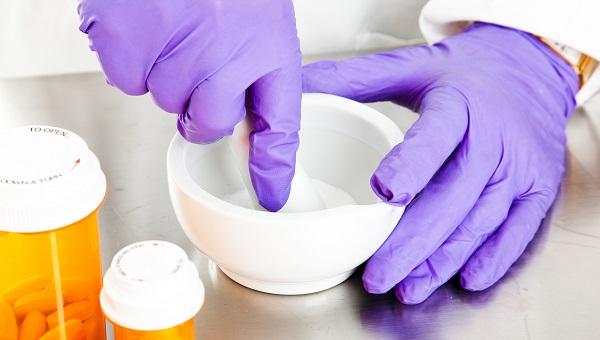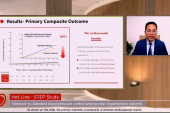‘Quadpill’ Beats Monotherapy at BP Lowering: QUARTET
Four drugs given at quarter doses in one capsule were better at reducing systolic BP and maintaining control through 1 year.

A single, daily “quadpill” combining four antihypertensive drugs, each given at quarter doses, is better than standard-dose irbesartan monotherapy at reducing systolic blood pressure by 12 weeks, according to the randomized QUARTET trial.
Both at 12 weeks and 1 year, rates of blood pressure control were higher among patients who started on the combo pill, suggesting a new way to tackle hypertension.
“Blood pressure control is poor globally, and this is despite the availability of many, many blood pressure medicines across the world,” Clara K. Chow, MBBS, PhD (University of Sydney, Australia), said in her virtual presentation at the recent European Society of Cardiology (ESC) Congress.
Barriers to better control, she told attendees, include the need for multiple medications, treatment inertia, and concerns about adverse events that can occur, sometimes due to too much BP lowering. In the SPRINT trial, for instance, most patients were on at least two antihypertensives, Chow noted.
Thus, “simpler, more-effective treatment strategies are needed,” Chow and colleagues note in the Lancet, where the results were published in conjunction with ESC 2021. The QUARTET trial, they say, has “demonstrated the efficacy, tolerability, and simplicity of a quadpill-based strategy.”
To TCTMD, Chow said they were surprised to see that the quadpill’s benefits were maintained at 12 months, consistent with the 12-week differences. “We expected they would erode as both arms were able to uptitrate the BP medicines,” she noted in an email, pointing out that this occurred despite uptitration being more common in the control arm.
Polypills have shown promise at reducing CV events in the TIPS-3 and PolyIran trials, where the combinations included not only antihypertensives but also statins and aspirin. Here, the focus was strictly on reducing blood pressure in patients with hypertension.
Getting to Target
For the double-blind QUARTET trial, researchers randomly assigned 591 Australian adults to initial treatment with either the quadpill (irbesartan 37.5 mg, amlodipine 1.25 mg, indapamide 0.625 mg, and bisoprolol 2.5 mg in a single capsule) or standard-dose monotherapy (irbesartan 150 mg). Enrollment criteria included age ≥ 18 years with a diagnosis from a general practitioner, pharmacist, or other healthcare provider plus being in one of these two categories:
- Untreated ≥ 4 weeks with a clinic systolic BP ≥ 140/90 mm Hg or daytime 24-hr ambulatory BP ≥ 135/85 mm Hg
- On monotherapy with clinic systolic BP ≥ 130/85 mm Hg or daytime ambulatory BP ≥ 125/80 mm Hg
Mean patient age was 59 years; 60% of participants were male, and 82% were white and 12% Asian, with the remaining 6% reported as “other” ethnicity. At baseline, their mean unattended office BP was 141/85 mm Hg.
Blood pressure control was defined as standard office BP < 140/90 mm Hg.
If their BP did not reach the target, patients in both groups could receive intensified treatment, starting with amlodipine at 5 mg. By 12 weeks, 84% of the quadpill group and 58% of the monotherapy group were on their assigned study drug. By 52-week follow-up, the proportions were 79% and 57%, respectively.
Mean unattended office systolic BP at 12 weeks, the primary endpoint, was 6.9 mm Hg lower for quadpill patients than it was for controls (P < 0.001), with a corresponding difference in the proportion who achieved blood pressure control (76% vs 58%; relative risk 1.30; 95% CI 1.15-1.47). Both daytime and nighttime BP were lower with the quadpill.
Ten serious adverse events occurred within 12 weeks: seven in the intervention group (3%; positional vertigo, shortness of breath, noncardiac chest pain, tonic clonic seizure, ankle fracture, cholecystitis, and migraine) and three in the control group (1%; noncardiac chest pain, pneumonia, and MI). There were no differences when it came to side effects. Treatment withdrawal due to any adverse occurred at similar frequency in both groups (4.0% vs 2.4%; P= 0.27), leaving 417 patients who continued therapy.
By 52 weeks, quadpill patients continued to have lower unattended systolic BP (by 7.7 mm Hg) and a higher BP control rate than did controls (81% vs 62%; RR 1.32; 95% CI 1.16-1.50).
Why Four?
Thomas Kahan, MD, PhD (Karolinska Institutet, Danderyd Hospital, Stockholm, Sweden), who wrote an editorial accompanying the Lancet paper and also chaired the ESC session where it was presented, commented that the QUARTET results are in line with current European and US recommendations “to start not with single therapy but rather with more than one drug—here four drugs.” He asked Chow about the number of medications included. “Is four better than three? Or two? Or should we have even more drugs at low doses? Do we know anything about that?”
“This was a concept trial,” she replied. “What we were trying to show was that starting on ultra-low-dose combination was a more effective approach than not starting on [that regimen].” In other words, Chow explained, “we were really comparing it against what the majority of people around the planet are still doing, which is starting on one drug and slowly but surely . . . stepping it up.” This idea mattered more than the specific number included, she added, though it would be interesting to look further into how the quadpill’s tolerability compares with common drug combinations now in use.
Kahan’s editorial further explains the rationale behind QUARTET: “Most of the effect on blood pressure reduction and the lowest risk for side effects is achieved with low doses for most antihypertensive drug classes, suggesting that starting treatment with a combination of blood pressure-lowering medicines at low doses might improve blood pressure control.” The findings make a strong argument for this approach, he agrees, calling for research on the optimal number of antihypertensive agents, whether the best dosing might differ by race, and potential effects on CVD beyond BP reduction.
Another key finding from the trial, said session chair Felix Mahfoud, MD (Saarland University Hospital, Homburg, Germany), is that the time to control was shorter for the combination versus monotherapy. “This is something worth considering in clinical practice, where we aim to get patients to blood pressure control as quickly as possible,” he suggested.
As for real-world use, it’s possible physicians could mimic the quadpill by asking pharmacists to combine its components into a capsule, “or even a dosette box or similar dose-aid-type device,” Chow told TCTMD. “There are no manufacturers that currently make an ultra-low-dose quadruple combination, and probably it would require collaboration between companies to do this.”
Next up, she said, the QUARTET trial is being replicated in the United States.
Caitlin E. Cox is News Editor of TCTMD and Associate Director, Editorial Content at the Cardiovascular Research Foundation. She produces the…
Read Full BioSources
Chow CK, Atkins ER, Hillis GS, et al. Initial treatment with a single pill containing quadruple combination of quarter doses of blood pressure medicines versus standard dose monotherapy in patients with hypertension (QUARTET): a phase 3, randomised, double-blind, active-controlled trial. Lancet. 2021;Epub ahead of print.
Disclosures
- The George Institute has submitted patent applications with respect to low-fixed-dose combination products for the treatment of cardiovascular and cardiometabolic disease, with Chow listed along with co-author Anthony Rodgers, PhD, as inventors.
- Chow and Rogers report having no direct financial interest in these patent applications or investments.
- Kahan reports research grants to Karolinska Institutet from Amgen, Medtronic, and ReCor Medical, all outside the area of work commented on here.





Comments